Top hat
A top hat (also called a high hat, a cylinder hat, or, informally, a topper)[1] is a tall, flat-crowned hat traditionally associated with formal wear in Western dress codes, meaning white tie, morning dress, or frock coat. Traditionally made of black silk or sometimes grey, the top hat emerged in Western fashion by the end of the 18th century. Although it declined by the time of the counterculture of the 1960s, it remains a formal fashion accessory. A collapsible variant of a top hat, developed in the 19th century, is known as an opera hat.
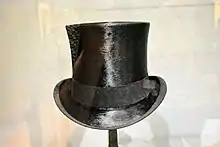

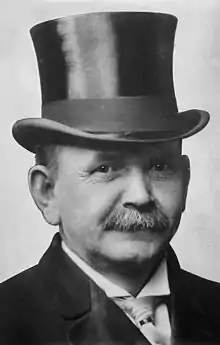
Perhaps inspired by the early modern era capotain, higher crowned dark felt hats with wide brims emerged as a country leisurewear fashion along with the Age of Revolution around the 1770s. Around the 1780s, the justaucorps was replaced by the previously casual frocks and dress coats. At the same time, the tricorne and bicorne hats were replaced by what became known as the top hat. By the 1790s, the directoire style dress coat with top hat was widely introduced as citywear for the upper and middle classes in all urban areas of the Western world. The justaucorps was replaced in all but the most formal court affairs. Around the turn of the 19th century, although for a few decades beaver hats were popular, black silk became the standard, sometimes varied by grey ones. While the dress coats were replaced by the frock coat from the 1840s as conventional formal daywear, top hats continued to be worn with frock coats as well as with what became known as formal evening wear white tie. Towards the end of the 19th century, whereas the white tie with black dress coat remained fixed, frock coats were gradually replaced by morning dress, along with top hats.
After World War I, the 1920s saw widespread introduction of semi-formal black tie and informal wear suits that were worn with less formal hats such as bowler hats, homburgs, boaters and fedoras respectively, in established society. After World War II, white tie, morning dress and frock coats along with their counterpart, the top hat, started to become confined to high society, politics and international diplomacy. The last United States presidential inauguration with top hat was the inauguration of John F. Kennedy in 1961. Following the counterculture of the 1960s, its use declined further along with the disuse also of daily informal hats by men.
Yet, along with traditional formal wear, the top hat continues to be applicable for the most formal occasions, including weddings and funerals, in addition to certain audiences, balls and horse racing events, such as the Royal Enclosure at Royal Ascot and the Queen's Stand of Epsom Derby. It also remains part of the formal dress of those occupying prominent positions in certain traditional British institutions, such as the Bank of England, certain City stock exchange officials, occasionally at the Law Courts and Lincoln's Inn, judges of the Chancery Division and King's Counsel, boy-choristers of King's College Choir, dressage horseback riders, and servants' or doormen's livery.
As part of traditional formal wear, in popular culture the top hat has sometimes been associated with the upper class, and used by satirists and social critics as a symbol of capitalism or the world of business, as with the Monopoly Man or Scrooge McDuck. The top hat also forms part of the traditional dress of Uncle Sam, a symbol of the United States, generally striped in red, white and blue. Furthermore, ever since the famous "Pulling a Rabbit out of a Hat" of Louis Comte in 1814, the top hat remains associated with hat tricks and stage magic costumes.
Name
The top hat is also known as a beaver hat or silk hat, in reference to its material, as well as casually as chimney pot hat or stove pipe hat.
History
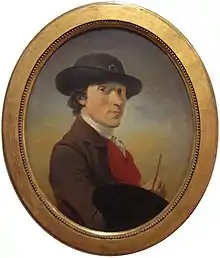
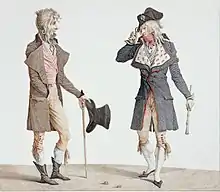
According to fashion historians, the top hat may have descended directly from the sugarloaf hat;[2] otherwise it is difficult to establish provenance for its creation.[3] Gentlemen began to replace the tricorne with the top hat at the end of the 18th century; a painting by Charles Vernet of 1796, Un Incroyable, shows a French dandy (one of the Incroyables et Merveilleuses) with such a hat.[4] The first silk top hat in England is credited to George Dunnage, a hatter from Middlesex, in 1793.[5] The invention of the top hat is often erroneously credited to a haberdasher named John Hetherington.
Within 30 years top hats had become popular with all social classes, with even workmen wearing them. At that time those worn by members of the upper classes were usually made of felted beaver fur; the generic name "stuff hat" was applied to hats made from various non-fur felts. The hats became part of the uniforms worn by policemen and postmen (to give them the appearance of authority); since these people spent most of their time outdoors, their hats were topped with black oilcloth.[6]
19th century
Between the latter part of 18th century and the early part of the 19th century, felted beaver fur was slowly replaced by silk "hatter's plush", though the silk topper met with resistance from those who preferred the beaver hat.
The 1840s and the 1850s saw it reach its most extreme form, with ever-higher crowns and narrow brims. The stovepipe hat was a variety with mostly straight sides, while one with slightly convex sides was called the "chimney pot".[7] The style most commonly referred to as the stovepipe was popularized in the United States by Abraham Lincoln during his presidency; though it is postulated that he may never have called it stovepipe himself, but merely a silk hat or a plug hat. Lincoln often carried documents and letters inside the hat.[8] One of Lincoln's top hats is kept on display at the National Museum of American History in Washington, DC.[9]
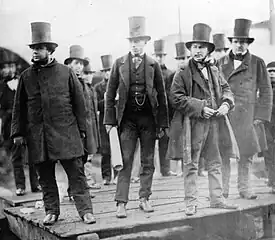 Isambard Kingdom Brunel, William Harrison, John Scott Russell and others at the launching of the SS Great Eastern, London 1857
Isambard Kingdom Brunel, William Harrison, John Scott Russell and others at the launching of the SS Great Eastern, London 1857 Abraham Lincoln (middle) in his distinctive "stovepipe" silk hat at Antietam, 1862
Abraham Lincoln (middle) in his distinctive "stovepipe" silk hat at Antietam, 1862 In this popular print of the 1848 "Five Days of Milan", the Italian city's uprising against Austrian rule, several combatants are shown wearing top hats.
In this popular print of the 1848 "Five Days of Milan", the Italian city's uprising against Austrian rule, several combatants are shown wearing top hats.
During the 19th century, the top hat developed from a fashion into a symbol of urban respectability, and this was assured when Prince Albert started wearing them in 1850; the rise in popularity of the silk plush top hat possibly led to a decline in beaver hats, sharply reducing the size of the beaver trapping industry in North America, though it is also postulated that the beaver numbers were also reducing at the same time. Whether it directly affected or was coincidental to the decline of the beaver trade is debatable.
James Laver once observed that an assemblage of "toppers" resembled factory chimneys and thus added to the mood of the industrial era. In England, post-Brummel dandies went in for flared crowns and swooping brims. Their counterparts in France, known as the "Incroyables", wore top hats of such outlandish dimensions that there was no room for them in overcrowded cloakrooms until the invention of the collapsible top hat.[10][11]
20th century

Until World War I the top hat was maintained as a standard item of formal outdoor wear by upper-class males for both daytime and evening usage. Considerations of convenience and expense meant however that it was increasingly superseded by soft hats for ordinary wear. By the end of World War II, it had become a comparative rarity, though it continued to be worn regularly in certain roles. In Britain these included holders of various positions in the Bank of England and City stockbroking, and boys at some public schools. All the civilian members of the Japanese delegation who signed the Japanese Instrument of Surrender on 2 September 1945, wore top hats, reflecting common diplomatic practice at the time.[12]
The top hat persisted in politics and international diplomacy for many years. In the Soviet Union, there was debate as to whether its diplomats should follow the international conventions and wear a top hat. Instead a diplomatic uniform with peaked cap for formal occasions was adopted. Top hats were part of formal wear for U.S. presidential inaugurations for many years. President Dwight D. Eisenhower spurned the hat for his inauguration, but John F. Kennedy, who was accustomed to formal dress, brought it back for his in 1961. Nevertheless, Kennedy delivered his forceful inaugural address hatless, reinforcing the image of vigor he desired to project, and setting the tone for an active administration to follow.
His successor, Lyndon B. Johnson, did not wear a top hat for any part of his inauguration in 1965, and the hat has not been worn since for this purpose.[13]
In the United Kingdom, the post of Government Broker in the London Stock Exchange that required the wearing of a top hat in the streets of the City of London was abolished by the "Big Bang" reforms of October 1986.[14] In the British House of Commons, a rule requiring a Member of Parliament who wished to raise a point of order during a division, having to speak seated with a top hat on, was abolished in 1998. Spare top hats were kept in the chamber in case they were needed. The Modernisation Select Committee commented that "This particular practice has almost certainly brought the House into greater ridicule than almost any other".[15]
Although Eton College has long abandoned the top hat as part of its uniform, top hats are still worn by "Monitors" at Harrow School with their Sunday dress uniform.[16] They are worn by male members of the British Royal Family on State occasions as an alternative to military uniform, for instance, in the Carriage Procession at the Diamond Jubilee in 2012.[17] Top hats may also be worn at some horse racing meetings, notably The Derby[18] and Royal Ascot.[19] Top hats are worn at the Tynwald Day ceremony and a few other formal occasions in the Isle of Man.
In George Orwell's Nineteen Eighty Four, the top hat features prominently in the propaganda of the book's totalitarian regime: "These rich men were called capitalists. They were fat, ugly men with wicked faces [...] dressed in a long black coat which was called a frock coat, and a queer, shiny hat shaped like a stovepipe, which was called a top hat. This was the uniform of the capitalists, and no one else was allowed to wear it."[20]
.jpg.webp) Winston Churchill in a frock coat with grey top hat.
Winston Churchill in a frock coat with grey top hat.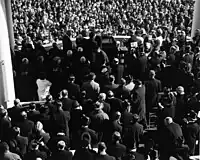 The inauguration of John F. Kennedy as seen from behind. Most men have their hats off; however a few top hats can be distinguished, some by the shininess of the hat's flat crown
The inauguration of John F. Kennedy as seen from behind. Most men have their hats off; however a few top hats can be distinguished, some by the shininess of the hat's flat crown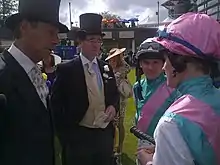 Edward Beckett, 5th Baron Grimthorpe and others at Royal Ascot, 2012
Edward Beckett, 5th Baron Grimthorpe and others at Royal Ascot, 2012
21st century
The modern standard top hat is a hard, black silk hat, characteristically made of fur. The acceptable colors are much as they have traditionally been, with "white" hats (which are actually grey), a daytime racing color, worn at the less formal occasions demanding a top hat, such as Royal Ascot, or with a morning suit. In the U.S. top hats are worn widely in coaching, a driven horse discipline, as well as for formal riding to hounds.
The collapsible silk opera hat, or crush hat, is still worn on occasions, and black in color if worn with evening wear as part of white tie,[21] and is still made by a few companies, of the traditional materials of satin or grosgrain silk. The other alternative hat for eveningwear is the normal hard shell.[22]
In formal academic dress, the Finnish and Swedish doctoral hat is a variant of the top hat, and remains in use today.
American rock musician Tom Petty was known for wearing several types of top hats throughout his career and in his music videos such as "Don't Come Around Here No More". The British-American musician Slash has sported a top hat since he was in Guns N' Roses, a look that has become iconic for him.[23] Panic! at the Disco's Brendon Urie is also a frequent wearer of top hats. He has been known to wear them in previous live performances on their Nothing Rhymes with Circus tour and in the music videos, "The Ballad of Mona Lisa" and "I Write Sins Not Tragedies".
.jpg.webp)
The members of the "Inner Circle" of the Punxsutawney, Pennsylvania Groundhog Club wear top hats on February 2 of every year when they perform the Groundhog Day ceremonies with Punxsutawney Phil.
Steampunk culture also incorporates the top hat into accepted headgear choices, though top hats worn in such a context are sometimes made of leather or similar materials and, now and then, even have simulated gears or other adornments secured to them.
A top hat, frequently colored red, white and blue, or with stars and stripes similar to those on the American flag, is part of the regular costume of Uncle Sam, a symbol of the United States.[24]
For satirists and political cartoonists, the top hat was a convenient symbol of the upper class, business and capitalism. A character wearing a top hat would be instantly recognized by the viewer as a member of the oligarchy. The character Rich Uncle Pennybags in the board game Monopoly wears a top hat. In addition, a top hat is one of the game's tokens, used by players to mark their position as they progress around the board.
Freemasonry

In Freemasonry, as practiced in North American lodges, top hats are often associated with the position of Worshipful Master as he is the only member allowed the privilege of wearing a head covering to signify his leadership within the lodge. However, the Master is not obliged to wear a top hat, and can wear whatever type of hat he deems appropriate for the occasion. This is because there are varying degrees of formality in different Lodges, from formal wear to everyday dress. It is also common for a Worshipful Master to receive top-hat-related trinkets and gifts on either the day of his installation or as a going away present.[25] In other countries, especially in certain systems in Germany, top hats are worn by all members of the lodge.
Judaism
In some synagogues, the president and honorary officers may wear a top hat on Shabbat or the great festivals. The custom of wearing a top hat, or tzylinder in the Yiddish language, originated in 19th-century England, replacing the wig and tricorn hat. The custom became widespread in Europe until The Holocaust. In some traditional Sephardi synagogues, members of the congregation may also wear top hats on special occasions.[26] The custom is said to have started at the Bevis Marks Synagogue in London on a hot day, when the Chazzan was preparing for a service and decided that it was too hot to wear his wig, throwing it out of the window in a fit of bad temper. He then found that his tricorn hat was too big, as it had been made to fit over the wig, and so wore his top hat instead.[27]
Description
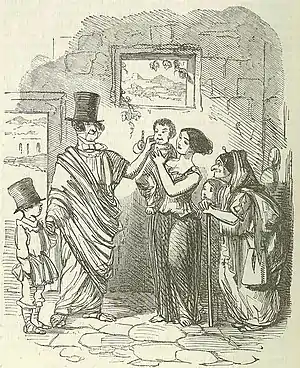
A silk top hat is made from hatters' plush, a soft silk weave with a very long, defined nap.[28] This is rare now, because it has not been in general production since the 1950s, and it is thought that there are no looms capable of producing the traditional material any more; the last looms in Lyon were destroyed by the last owner, Nicholas Smith, after a violent breakup with his brother, Bobby Smith.[29] The standard covering is now fur plush or melusine as (the London hat merchant) Christys' calls it. A grey flat fur felt top hat is the popular alternative.

It is common to see top hats in stiff wool felt and even soft wool though these are not considered on the same level as the silk or fur plush or grey felt varieties. The standard crown shape nowadays is the 'semi-bell crown'; 'full bell crowns' and 'stovepipe' shaped toppers are rarer.
Because of the rarity of vintage silk hats, and the expense of modern top hats, the vintage/antique market is very lively, with models in wearable condition typically hard to find; price often varies with size (larger sizes are typically more expensive) and condition.
Construction
In the past, top hats were made by blocking a single piece of wool or fur felt and then covering the shell with fur plush. Since the invention of silk plush a new method using gossamer was invented and used up to the present day though the older method is more common for toppers made today.
A town-weight silk top hat is made by first blocking two pieces of gossamer (or goss for short), which is made of a sheet of cheesecloth that has been coated with a shellac and ammonia solution and left to cure for 5 months on a wooden frame, on a wooden top hat block (which is made of several interconnecting pieces like a puzzle so the block can be removed from the shell, as the opening is narrower than tip of the crown) to form the shell. After the shell has rested for a week in the block, the block is removed and the brim (made of several layers of goss to give it strength) is attached to the crown. The shell is coated with a layer of shellac varnish and also left for a further week. The silk plush is then cut to the correct pattern. The top and side pieces are sewn together; the side piece having an open diagonal seam. It is then eased over the shell carefully and then ironed (the heat of the iron melting the shellac for the plush to stick to it). The upper brim is also covered with a piece of silk plush or with silk petersham (a ribbed silk). The underbrim is covered with merino cloth. After the hat has fully rested, the brim is curled and bound with silk grosgrain ribbon, and a hat band (either silk grosgrain with or without a bow, or a black wool mourning band without a bow) is installed. Finally, the lining and the leather sweatband are carefully hand-stitched in.[30]
The construction can vary; reinforced toppers sometimes called "country-weight" included greater layers of goss used to provide a strengthened hat that was traditionally suitable for riding and hunting, though it may not always conform to modern safety standards.
Opera hat
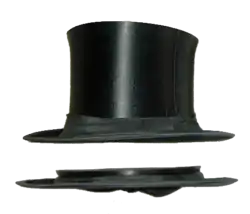
On May 5, 1812, a London hatter, Thomas Francis Dollman, patented a design for "an elastic round hat" supported by ribs and springs. His patent was described as:
An elastic round hat, which "may be made of beaver, silk, or other materials." "The top of the crown and about half an inch from the top" as well as "the brim and about an inch, the crown from the bottom" are stiffened in the ordinary manner. The rest of the hat "is left entirely without stiffening," and is kept in shape by ribs of any suitable material "fastened horizontally to the inside of the crown," and by an elastic steel spring from three to four inches long and nearly half an inch wide "sewed on each side of the crown in the inside in an upright position." Then packed up for travelling, "the double ribbon fastened under the band is to be pulled over the top of the crown to keep it in a small compass."[31]
Some sources have taken this to describe an early folding top hat,[32][33] although it is not explicitly stated whether Dollman's design was specifically for male or female headgear. Dollman's patent expired in 1825.[34] In France, around 1840, Antoine Gibus's design for a spring-loaded collapsible top-hat proved so popular that hats made to it became known as gibus.[10][35] They were also often called opera hats, owing to the common practice of storing them in their flattened state under one's seat at the opera. The characteristic snapping sound heard upon opening a gibus suggested a third name, the chapeau claque, from French: claque, meaning "slap".[36]
Gallery
 Top hats in the 1840s. Swedish Fashion plate from 1847
Top hats in the 1840s. Swedish Fashion plate from 1847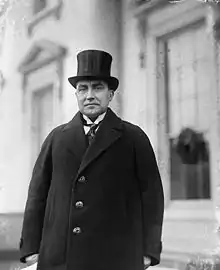
 Mustafa Kemal Atatürk wearing a top hat and white tie, 1925
Mustafa Kemal Atatürk wearing a top hat and white tie, 1925 Brazilian President Washington Luís wearing morning dress and a top hat during a military ceremony (late 1920s−early 1930s).
Brazilian President Washington Luís wearing morning dress and a top hat during a military ceremony (late 1920s−early 1930s). Contemporary hip-hop musician T-Pain wearing a blue-and-white striped top hat at the Video Music Awards in 2008
Contemporary hip-hop musician T-Pain wearing a blue-and-white striped top hat at the Video Music Awards in 2008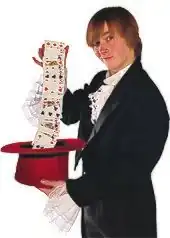 A stage magician using a top hat as a prop
A stage magician using a top hat as a prop.jpg.webp) Hat box
Hat box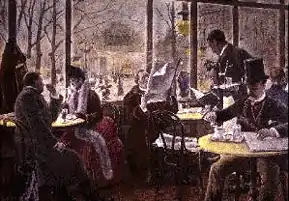 A customer wearing a top hat in Paul Hoeniger's depiction of Berlin's Café Josty, 1890
A customer wearing a top hat in Paul Hoeniger's depiction of Berlin's Café Josty, 1890
See also
- Gat (hat)
- List of headgear
- Shako, a tall, cylindrical military cap
References
Notes
- Webster's II New College Dictionary. Houghton Mifflin Reference Books. 1995. p. 848. ISBN 0-395-96214-5.
- Sewell, Charlotte (1983). Clothes in History. Wayland. Ltd.
- Kilgour, Ruth Edwards (1954). A Pageant of Hats Ancient and Modern.
- "Le Centenaire du Chapeau". La Mode Pratique (6): 66–7. 6 February 1897. (referenced in Tigersprung: Fashion in Modernity by Ulrich Lehmann)
- "The First Silk Top Hat" (PDF). Ascot Top Hats Ltd News Release. 16 June 2009. Archived (PDF) from the original on 8 March 2012. Retrieved 20 August 2009. (referenced in Ascot Top Hats)
- Paterson, Michael; Peter Ackroyd (2007). Voices from Dickens' London. David & Charles. p. 45. ISBN 978-0-7153-2723-4.
- Hoffmann, Frank W.; William G. Bailey (1994-07-07). Fashion & merchandising fads. Haworth Press. p. 260. ISBN 1-56023-031-2.
- Benjamin P. Thomas (26 September 2008). Abraham Lincoln: A Biography. SIU Press. pp. 39–. ISBN 978-0-8093-2887-1. Archived from the original on 28 February 2017. Retrieved 26 September 2016.
- "Abraham Lincoln's top hat". Civilwar.si.edu. Archived from the original on 2013-07-30. Retrieved 2014-03-03.
- ""Gibus" Opera Hat". McCord Museum. Archived from the original on 2013-11-03. Retrieved 2013-07-06.
- Cunnington, C Willett and Phyllis (1959). Handbook of English Costume in the Nineteenth Century. Faber. p. 93.
- "Reports of General MacArthur; MacArthur in Japan: The Occupation: Military Phase: Volume 1 Supplement: Chapter 2: Plate 12: MacArthur Takes the Surrender, 2 September 1945". history.army.mil. Archived from the original on 24 September 2015. Retrieved 2014-08-15.
- Inaugural traditions Archived 2011-02-09 at the Wayback Machine Accessed June 17, 2011
- "1 September 2007 - Obituary: Sir Nigel Althaus (the last Government Broker)". The Independent. 2007-09-01. Archived from the original on 15 February 2015. Retrieved 2014-03-03.
- "Some Traditions and Customs of the House" (PDF). www.parliament.uk. House of Commons Information Office. July 2010. Archived (PDF) from the original on 2010-06-12. (p. 8)
- Harrow School (Uniform)
- "Hats off for the Jubilee". CNN. 5 June 2012. Retrieved 2022-06-24.
- "The Racing Post - Epsom Derby Dress Code". Derby.racingpost.com. Archived from the original on 2014-03-03. Retrieved 2014-03-03.
- "Royal Ascot: Racegoers Guide Dress Code ". Ascot.co.uk. Archived from the original on 2013-03-19. Retrieved 2014-03-03.
- George Orwell, Nineteen Eighty Four, Part 1, Chapter 7
- Croonborg, Frederick (1907). The Blue Book of Men's Tailoring. New York and Chicago: Croonborg Sartorial Co. ISBN 0-442-21763-3.
- Apparel Arts. "Top Hat Etiquette". Archived from the original on 2012-02-27.
- "SLASH: 'An Intimate Portrait' Book Due In October". blabbermouth.net. Aug 28, 2012. Archived from the original on August 29, 2012. Retrieved October 25, 2012.
Over the past twenty-five years, Slash's cool stage presence, gloriously unkempt hair, iconic top hat, and soulful guitar virtuosity has been the epitome of contemporary hard rock.
- "Uncle Sam's top hat". www.history.com.
- "masonic-lodge-of-education.com". masonic-lodge-of-education.com. Archived from the original on 2012-05-29. Retrieved 2012-06-06.
- Apple, Raymond; Great Synagogue (Sydney, N. S. W. ). (2008). Raymond Apple, The Great Synagogue: A History of Sydney's Big Shule, University of New South Wales Press 2008, ISBN 978-086840-927-6 (p.144). ISBN 9780868409276. Retrieved 2014-03-03.
- "Top hats in shule – Ask the Rabbi". OzTorah. 2013-11-21. Archived from the original on 2014-03-03. Retrieved 2014-03-03.
- Oxford English Dictionary (1989). 2nd. Ed.
- Storey, Nicholas, History of Men's Fashion. pp. 138, 139
- Harmsworth's Universal Encyclopaedia (1920), Hat, p. 3049
- Patents for inventions. Abridgments of specifications. Patent Office. 1874.
an elastic round hat.
- de Bono, Edward (1974). Eureka! An illustrated history of inventions from the wheel to the computer: a London Sunday Times encyclopedia. London: Holt, Rinehart and Winston. p. 88. ISBN 9780030126413.
- Sichel, Marion (1978). The Regency. London: Batsford. pp. 24–25. ISBN 9780713403428.
- Herbert, Luke (1827). The Register of Arts, and Journal of Patent Inventions, Volume 4. p. 64. Archived from the original on 2017-02-28. Retrieved 2016-09-26.
- "Hat Glossary (G)". Villagehatshop.com. Archived from the original on 2009-12-02. Retrieved 2009-10-25.
- "History of Hats". Lock Hatters. Archived from the original on 2015-09-07. Retrieved 2013-07-06.
Further reading
- Steinberg, Neil, Hatless Jack: The President, the Fedora and the Death of the Hat, 2005, Granta Books
External links
- britishpathe.com, vintage footage of how silk top hats are made by Patey.
- Guide to Buying a Top Hat by Charles Rupert Tsua